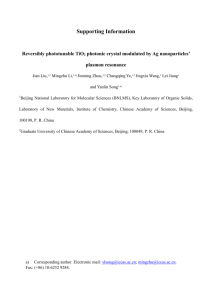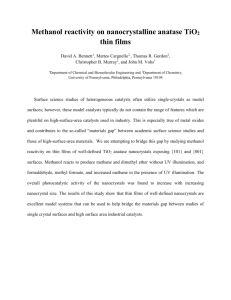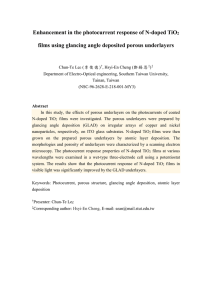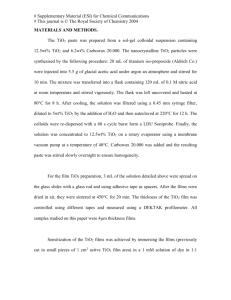0608896 Dixon - NSF Nanoscale Science and Engineering
advertisement
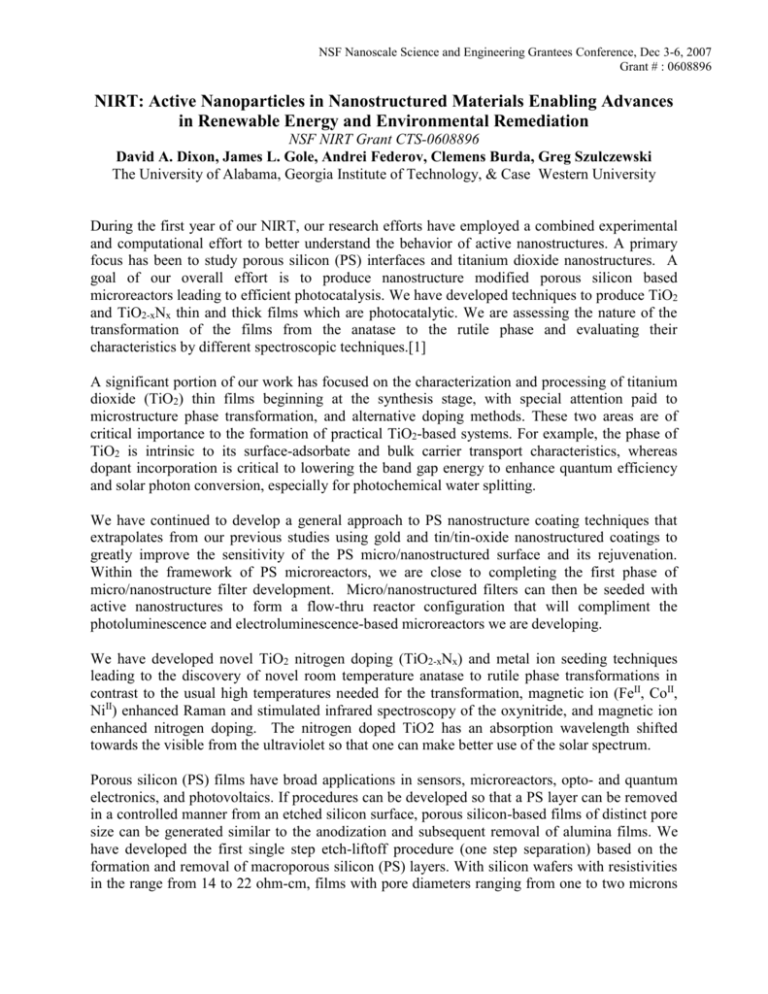
NSF Nanoscale Science and Engineering Grantees Conference, Dec 3-6, 2007 Grant # : 0608896 NIRT: Active Nanoparticles in Nanostructured Materials Enabling Advances in Renewable Energy and Environmental Remediation NSF NIRT Grant CTS-0608896 David A. Dixon, James L. Gole, Andrei Federov, Clemens Burda, Greg Szulczewski The University of Alabama, Georgia Institute of Technology, & Case Western University During the first year of our NIRT, our research efforts have employed a combined experimental and computational effort to better understand the behavior of active nanostructures. A primary focus has been to study porous silicon (PS) interfaces and titanium dioxide nanostructures. A goal of our overall effort is to produce nanostructure modified porous silicon based microreactors leading to efficient photocatalysis. We have developed techniques to produce TiO2 and TiO2-xNx thin and thick films which are photocatalytic. We are assessing the nature of the transformation of the films from the anatase to the rutile phase and evaluating their characteristics by different spectroscopic techniques.[1] A significant portion of our work has focused on the characterization and processing of titanium dioxide (TiO2) thin films beginning at the synthesis stage, with special attention paid to microstructure phase transformation, and alternative doping methods. These two areas are of critical importance to the formation of practical TiO2-based systems. For example, the phase of TiO2 is intrinsic to its surface-adsorbate and bulk carrier transport characteristics, whereas dopant incorporation is critical to lowering the band gap energy to enhance quantum efficiency and solar photon conversion, especially for photochemical water splitting. We have continued to develop a general approach to PS nanostructure coating techniques that extrapolates from our previous studies using gold and tin/tin-oxide nanostructured coatings to greatly improve the sensitivity of the PS micro/nanostructured surface and its rejuvenation. Within the framework of PS microreactors, we are close to completing the first phase of micro/nanostructure filter development. Micro/nanostructured filters can then be seeded with active nanostructures to form a flow-thru reactor configuration that will compliment the photoluminescence and electroluminescence-based microreactors we are developing. We have developed novel TiO2 nitrogen doping (TiO2-xNx) and metal ion seeding techniques leading to the discovery of novel room temperature anatase to rutile phase transformations in contrast to the usual high temperatures needed for the transformation, magnetic ion (FeII, CoII, NiII) enhanced Raman and stimulated infrared spectroscopy of the oxynitride, and magnetic ion enhanced nitrogen doping. The nitrogen doped TiO2 has an absorption wavelength shifted towards the visible from the ultraviolet so that one can make better use of the solar spectrum. Porous silicon (PS) films have broad applications in sensors, microreactors, opto- and quantum electronics, and photovoltaics. If procedures can be developed so that a PS layer can be removed in a controlled manner from an etched silicon surface, porous silicon-based films of distinct pore size can be generated similar to the anodization and subsequent removal of alumina films. We have developed the first single step etch-liftoff procedure (one step separation) based on the formation and removal of macroporous silicon (PS) layers. With silicon wafers with resistivities in the range from 14 to 22 ohm-cm, films with pore diameters ranging from one to two microns NSF Nanoscale Science and Engineering Grantees Conference, Dec 3-6, 2007 Grant # : 0608896 and thickness ranging from 3 to 70 micrometers have been prepared. These silicon-based films (filters), which carry a polarizing negative charge, represent an alternative to porous alumina (films) filters (pore diameter not yet in the one to two micron range) in terms of their size range and their potential interaction-reaction at elevated temperatures. Cu and Pt can be introduced to these filters using electroless solutions to create an effective reductive surface. Using these and alternate material combinations, interactive-reactive filters in the one micron size range which operate at temperatures well in excess of porous polymer films can be realized with potential applications as microreactors for chemical transformations.[2] Figure 1. Mechanical Lift-off of PS filter using the ability to readily remove the silicon oxyfluoride polymer that forms on the PS surface. Figure 2. Direct Lift-off of PS-based film- filter (~ 20 microns) from the surface of an etched PS film. Pore diameter is approximately one micron. Figure 3. SEM micrographs of a porous silicon filter. From the left, the tips of the pores can be seen before and after they begin to spread out in their face directions. The next two images show the front and back of a filter. Note that pore spreading is significant in the filter back. Recent studies in our laboratories have suggested the importance of structural porosity as it influences and enhances the rate and efficiency of the main group nitrogen doping process in porous TiO2 nanocolloids to form improved visible light absorbing oxynitride photocatalysts at the nanoscale. The seeding of the high spin transition metal ions Co (II) and Ni (II) into porous nanoscale nitrogen doped titanium oxynitride, TiO2-xNx structures leads to a significant enhancement of the infrared spectrum due to adventitious water and minor contaminants associated with the oxynitride synthesis from a porous TiO2 nanocolloid sample. There are a number of contributions to the infrared enhancement (1) the formation of protonated amines near NSF Nanoscale Science and Engineering Grantees Conference, Dec 3-6, 2007 Grant # : 0608896 the oxynitride surface; (2) modification of the anatase ionic crystal dipole moment due to the displacement of charged ions by the electric field associated with the high spin Co (II) and Ni (II) ions; and (3) the incorporation of a spinel-like structure into the TiO2 lattice as demonstrated by Raman spectra. The presence of partial proton transfer from the amines to the surface can lead to enhanced intensities. The higher the proton affinity of the amine, the less proton transfer occurs leading to a higher N-H stretch frequency with less enhancement.[3] Figure 4. Note the enhancement of the infrared intensity in the region between 2000 and 3000 cm-1. The surprising room temperature phase conversion of anatase to rutile TiO2, a process that normally requires temperatures well in excess of 700 C, is facilitated through the use of transition metal ions with unpaired electron spin. Raman spectroscopy has been used to demonstrate this unexpected process, which is facilitated by sseding high spin cobalt (CoII ) and nickel (NiII) transition metal ions into a TiO2 or TiO2-xNx nanocolloid lattice. The low temperature transition is not observed upon seeding with low spin ions including CuII. The Raman spectra demonstrate the concomitant incorporation of a spinel-like structure into the titania lattice.[4] 442 606 240 10000 Raman Intensity 690 TiO2- .0125 Co TiO2- .025 Co TiO2- .05 Co TiO2- 0.1 Co with Co(Cl)2 244 Raman Intensity 430 606 380 TiO2-(NO3) 0.025 TiO2-(NO3) 0.05 TiO2-(NO3) 0.2 688 1000 100 1000 200 400 600 800 1000 -1 Wavenumber (cm ) 1200 200 400 600 800 1000 1200 -1 Wavenumber (cm ) Figure 4. Raman spectra for a TiO2 nanocolloid (<10 nm) prepared with various concentrations of CoII using a) CoCl2 and b) Co(NO3)2. The Raman signal was obtained using a 1 μm spot size and a power of 25 mW or less. Publications [1] For further information about this project email: dadixon@bama.ua.edu or jim.gole@physics.gatech.edu. [2] “Development of Porous-Silicon-based Active Microfilters,” J.Campbell, J.A. Corno, Ni.Larsen, and J.L. Gole, Georgia Institute of Technology, J. Electrochem . Soc. Accepted, Oct. 2007. [3] “Evidence for High Spin Transition Metal Ion Induced Infrared Spectral Enhancement,” J. L. Gole, S. M. Prokes, M. G. White, T.-H. Wang, R. Craciun, and D. A. Dixon, J. Phys. Chem., 2007, WEB ASAP, Oct. 24. [4] “Efficient Room Temperature Conversion of Anatase to Rutile TiO 2 Induced by High Spin Ion Doping,” J.L. Gole, S. M. Prokes, M. G. White, J. Phys. Chem. B, submitted. [5] “Experimental and Theoretical Studies of the Photoreduction of Copper(II)-Dendrimer Complexes,” H. Wan, S. Li, T. A. Konovalova, S. Shuler, D. A. Dixon, and S. C. Street, J. Phys. Chem., accepted, Oct. 2007.

